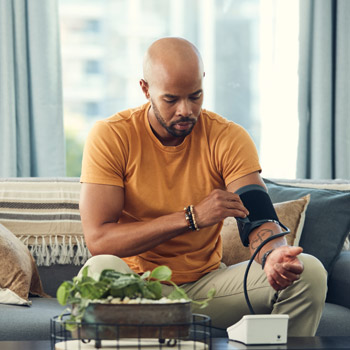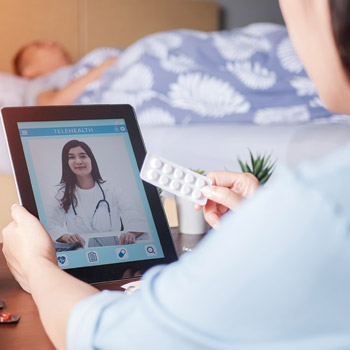Home BP monitoring works, but not as well alone
Home blood pressure monitoring needs to be combined with other interventions and the data collected must be used to engage the patient in some way to have the greatest effect.
Hypertension management is a multibillion-dollar problem in the United States, with annual costs expected to increase to $150 billion by 2025, according to Gbenga Ogedegbe, MD, MPH, FACP. But while telehealth, specifically home blood pressure (BP) monitoring, may help improve care and decrease expenses, it's only one part of the solution.
“My mantra is that home BP monitoring is necessary but not sufficient,” said Dr. Ogedegbe, who is the Dr. Adolph and Margaret Berger Professor of Medicine and Population Health at NYU Grossman School of Medicine in New York City. At Hypertension 2020, held virtually in September, he spoke about ideal implementation of this strategy, particularly in low-income and minority populations.

One benefit of home blood pressure monitoring is that it combats multiple barriers to hypertension control, Dr. Ogedegbe said. Patients who monitor their blood pressure at home tend to be more engaged in their care, resulting in improved adherence to medication and behavioral modifications, as well as increased self-efficacy, he noted. Home blood pressure monitoring can also improve access to care, which is especially important during the COVID-19 pandemic, when patients may be reluctant to attend in-person visits.
It can also help improve clinician engagement and reduce clinical inertia, which Dr. Ogedegbe defined as “when patients show up in clinic, the SBP [systolic blood pressure] is more than 140 mm Hg, and there is no adjustment of their medications. That tends to happen a lot.” If there is clinical uncertainty surrounding patients' blood pressure data, often due to the white-coat effect, clinicians may be reluctant to aggressively adjust hypertension regimens. Integration of home blood pressure data provides a more consistent picture, Dr. Ogedegbe said.
Support needed
To have the greatest effect, home blood pressure monitoring needs to be combined with other interventions, Dr. Ogedegbe said. After a patient provides monitoring results, the clinician must use the data to engage with the patient in some way, he stressed.
If the patient's blood pressure is under control, the clinician or practice could send a text saying, “Hey, well done, you're doing a good job,” Dr. Ogedegbe said. “If it's not, the text may say, ‘Hey, your BP is not under control, you may want to do XYZ.’” Other ways to engage with the patient include setting up a telemedicine visit or having a nurse manager get in touch, he said.
“The good news is that [home BP monitoring alone] brings down blood pressure,” he said. “The not-so-good news is that it doesn't do it as well without a co-intervention where you close that feedback.”
He cited a systematic review published in PLOS Medicine on Sept. 19, 2017, that looked at 36 studies of self-monitoring with no feedback, self-monitoring with web or phone feedback, self-monitoring with phone feedback and patient education, or self-monitoring with counseling or telecounseling. It found that self-monitoring in conjunction with co-interventions led to clinically significant blood pressure reduction that persisted for at least 12 months compared to self-monitoring alone.
In addition, the randomized TASMINH4 Study, which was published by The Lancet on March 10, 2018, aimed to determine the efficacy of home blood pressure monitoring with or without telemonitoring.
One group of patients received usual care, defined as titration of antihypertensive medications at clinic visits. In the second group, patients measured their blood pressure at home, and values were transmitted to clinicians, who could calculate averages and make any necessary medication adjustments. In the third group, patients were trained to self-monitor their blood pressure and use a color chart, like a traffic light, to decide when to contact their clinicians. Also, in this arm, clinicians could access patients' data through a web-based app that calculated the average blood pressure and sent automatic alerts to patients when values were too high or too low. Decreases were seen in systolic blood pressure in all groups at six months and 12 months but were greater in the intervention groups than the usual care one.
“Both telemonitoring and self-monitoring tend to work well. They're both superior to home BP use and usual care. So the jury is settled, actually, on the efficacy of both types of intervention,” Dr. Ogedegbe said.
The digital divide
Based on this evidence, “Home BP telemonitoring has proven efficacy … in addressing multilevel barriers to hypertension control,” Dr. Ogedegbe said. “What was not clear, though, is that disparate access and utilization of telehealth platforms may exacerbate health disparities in this era of increased use of telehealth.”
Sociocultural barriers to telehealth can include limited skill with technology, low health literacy, and limited English proficiency, while structural barriers include access to broadband capacity, computers, and smartphones, he said. “When you consider these together, at least one in every four Americans may not have digital literacy skills or access to internet-enabled digital devices to engage in video visits. Therein lies the digital divide.”
To determine whether telehealth programs for hypertension control can improve care in low-income and minority populations, Dr. Ogedegbe and his colleagues conducted the Stroke Telehealth Study, which looked at the comparative effectiveness of home blood pressure monitoring alone versus combined with telephone-based nurse case management among 450 stroke survivors with uncontrolled hypertension. A total of 51.3% of patients in the study were Black, and 48.7% were Hispanic. The primary outcomes were within-patient change in systolic blood pressure from baseline to 12 months and rate of recurrent stroke at 24 months. The study protocol was published by Trials on March 15, 2015.
In the home blood pressure monitoring group, patients measured their blood pressure at least three days a week for 12 months. Home blood pressure readings were transmitted wirelessly to a secure server, and reports were sent to physicians one week before each clinic appointment. In the nurse case management group, nurses evaluated patients' electronic health records and self-reported data and counseled them on target lifestyle behaviors based on their blood pressure readings. Nurse case manager calls were scheduled weekly in months 1 and 2 of the study, biweekly in months 3 and 4, and monthly in months 5 through 12.
Dr. Ogedegbe pointed out that 72% of study patients had an annual family income below $24,999, that 45.8% were obese, and that 48% had diabetes. Both interventions led to significant systolic blood pressure reduction at six months and at 12 months, but to different degrees. In the group with only home monitoring, “There's a reduction of about 6 mm Hg by 12 months,” he said. “When you look at the home BP telemonitoring plus nurse case management group, what you see is a drop of initially by about 14 points. And that went down even more, about 13 points, 12 months later, so the difference was sustained.”
These findings offer strong empirical evidence to support widespread implementation of home blood pressure monitoring with nurse case management in low-income stroke survivors with multiple comorbid conditions, Dr. Ogedegbe said. “Policymakers and health plans, frankly, now have the needed evidence to implement these strategies in minority patients with stroke and uncontrolled hypertension.”
What's next
Expanded insurance coverage for home blood pressure monitoring would be a first step toward this implementation. It currently varies among private insurance providers and Medicaid, and no national or local coverage rules address use of home blood pressure monitoring, Dr. Ogedegbe noted. “Although CMS finalized national coverage determination for the use of ambulatory blood pressure monitoring, it does not extend that coverage to home BP monitors,” he said.
But more coverage wouldn't necessarily address all the barriers to home monitoring that low-income minority patients face. Even when patients can obtain a home monitor, they may lack the internet service to transmit data to their clinicians, Dr. Ogedegbe noted. “And then there's a lack of private space in which to conduct virtual appointments,” he said, since low-income and minority patients are more likely to live in multigenerational households. Lack of direct integration of data from home blood pressure monitors into the electronic medical record and poor clinical decision support are additional issues that need to be addressed generally but that loom larger in care for populations where disparities already exist, he said.
Dr. Ogedegbe noted several opportunities for implementation of home blood pressure monitoring in low-income and minority populations. The Coronavirus Aid, Relief, and Economic Security (CARES) Act has allotted $1.32 billion for COVID-19 response and for maintaining the capacity of community health centers, which is where most low-income minority patients receive care, he said. These funds along with additional restructuring of the health care system due to the COVID-19 epidemic could help increase access to telehealth and therefore home blood pressure monitoring, as long as realistic reimbursement models are developed for non-COVID-19 telehealth care.
While HEDIS (Healthcare Effectiveness and Data Information Set), the most widely used health care performance metric, recently added the use of home blood pressure data for the assessment of blood pressure control, Dr. Ogedegbe noted that law- and policymakers should also work toward facilitating direct electronic transmission of these data to primary care clinicians.
“It makes life much easier for the small independent practices, who often don't have the ability to actually coordinate care because they have a huge patient load and a small staff. … They often don't have the infrastructure needed to actually engage in telehealth,” he said. “So there has to be a way for us to begin to integrate some of the bills that we have in Congress into helping to address these issues.”




